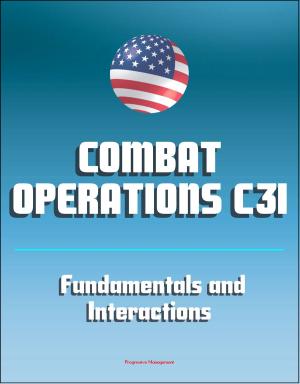Air Force Strategy Study 2020-2030: Power Projection, Freedom of Action in Air, Space, and Cyberspace, Global Situational Awareness, Military Support for Civil Authorities
Nonfiction, History, Military, Aviation, Social & Cultural Studies, Political Science| Author: | Progressive Management | ISBN: | 9781476068350 |
| Publisher: | Progressive Management | Publication: | July 3, 2012 |
| Imprint: | Smashwords Edition | Language: | English |
| Author: | Progressive Management |
| ISBN: | 9781476068350 |
| Publisher: | Progressive Management |
| Publication: | July 3, 2012 |
| Imprint: | Smashwords Edition |
| Language: | English |
In November 2009, Gen Norton A. Schwartz, the Air Force chief of staff, tasked the Air Force Research Institute (AFRI) to answer the following question: What critical capabilities—implemented by the combatant commanders—will the nation require of the Air Force by 2030? Preparing for the challenges of a geostrategic environment 20 years in the future required a multiphase research plan. First, the AFRI team identified the nation's vital interests: commerce; secure energy supplies; freedom of action at sea, in space, in cyberspace, and in the skies; nuclear deterrence; and regional stability. The team analyzed four future world scenarios—a peer competitor, resurgent power, failed state, and jihadist insurgency—in relation to the nation's vital interests and the 12 Air Force core functions. The resulting analysis led to a synthesis of the core functions into five critical capabilities designed to meet the Air Force's strategic challenges in 2030: power projection; freedom of action in air, space, and cyberspace; global situational awareness; air diplomacy; and military support to civil authorities (MSCA).
Contents * Executive Summary * Chapter 1 * INTRODUCTION * Background * Supporting Research * Chapter 2 * AIR FORCE CAPABILITIES * Air Force Critical Capabilities, 2020-30 * Power Projection * Freedom of Action: Air * Freedom of Action: Space * Freedom of Action: Cyber * Global Situational Awareness Air Diplomacy * Military Support to Civil Authorities * Conclusion * Notes * Chapter 3 * RECOMMENDATIONS * Power Projection * Freedom of Action: Air * Freedom of Action: Space * Freedom of Action: Cyber * Global Situational Awareness * Air Diplomacy * Military Support to Civil Authorities * Conclusion * Notes * Chapter 4 * CONCLUSION * Power Projection * Freedom of Action: Air, Space, and Cyber * Global Situational Awareness * Air Diplomacy * Military Support to Civil Authorities * Appendix A * National Interests and Shocks * The National Interest * Understanding the National Interest * The National Interest, 2010-30 * Summary of National Interests * Exogenous Shocks in the Geostrategic Environment, 2010-30 * Notes * Appendix B * Futures Research Methods * Overview of Scenario Planning * Introduction to Scenario Planning in the USAF * Three Key Trends * Notes * Appendix C * 2030 Scenarios * Scenario 1: Resurgent Power * Russia in 2030 * Impact on US National Interests * The US Air Force's Role * Summary * Notes * Scenario 2: Peer Competitor * China in 2030 * Impact on US National Interests * The US Air Force's Role * Summary * Notes * Scenario 3: Failed State * Nigeria in 2030 * Impact on US National Interests * The US Air Force's Role * Summary * Notes * Scenario 4: Jihadist Insurgency * Zendia in 2030 * Impact on US National Interests * The US Air Force's Role * Summary * Notes
In November 2009, Gen Norton A. Schwartz, the Air Force chief of staff, tasked the Air Force Research Institute (AFRI) to answer the following question: What critical capabilities—implemented by the combatant commanders—will the nation require of the Air Force by 2030? Preparing for the challenges of a geostrategic environment 20 years in the future required a multiphase research plan. First, the AFRI team identified the nation's vital interests: commerce; secure energy supplies; freedom of action at sea, in space, in cyberspace, and in the skies; nuclear deterrence; and regional stability. The team analyzed four future world scenarios—a peer competitor, resurgent power, failed state, and jihadist insurgency—in relation to the nation's vital interests and the 12 Air Force core functions. The resulting analysis led to a synthesis of the core functions into five critical capabilities designed to meet the Air Force's strategic challenges in 2030: power projection; freedom of action in air, space, and cyberspace; global situational awareness; air diplomacy; and military support to civil authorities (MSCA).
Contents * Executive Summary * Chapter 1 * INTRODUCTION * Background * Supporting Research * Chapter 2 * AIR FORCE CAPABILITIES * Air Force Critical Capabilities, 2020-30 * Power Projection * Freedom of Action: Air * Freedom of Action: Space * Freedom of Action: Cyber * Global Situational Awareness Air Diplomacy * Military Support to Civil Authorities * Conclusion * Notes * Chapter 3 * RECOMMENDATIONS * Power Projection * Freedom of Action: Air * Freedom of Action: Space * Freedom of Action: Cyber * Global Situational Awareness * Air Diplomacy * Military Support to Civil Authorities * Conclusion * Notes * Chapter 4 * CONCLUSION * Power Projection * Freedom of Action: Air, Space, and Cyber * Global Situational Awareness * Air Diplomacy * Military Support to Civil Authorities * Appendix A * National Interests and Shocks * The National Interest * Understanding the National Interest * The National Interest, 2010-30 * Summary of National Interests * Exogenous Shocks in the Geostrategic Environment, 2010-30 * Notes * Appendix B * Futures Research Methods * Overview of Scenario Planning * Introduction to Scenario Planning in the USAF * Three Key Trends * Notes * Appendix C * 2030 Scenarios * Scenario 1: Resurgent Power * Russia in 2030 * Impact on US National Interests * The US Air Force's Role * Summary * Notes * Scenario 2: Peer Competitor * China in 2030 * Impact on US National Interests * The US Air Force's Role * Summary * Notes * Scenario 3: Failed State * Nigeria in 2030 * Impact on US National Interests * The US Air Force's Role * Summary * Notes * Scenario 4: Jihadist Insurgency * Zendia in 2030 * Impact on US National Interests * The US Air Force's Role * Summary * Notes















